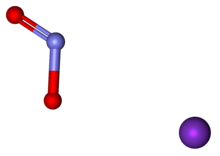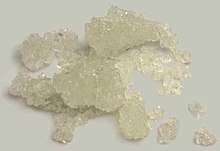Potassium nitrite
Potassium nitrite (distinct from potassium nitrate) is the inorganic compound with the chemical formula KNO2. It is an ionic salt of potassium ions K+ and nitrite ions NO2−, which forms a white or slightly yellow, hygroscopic crystalline powder that is soluble in water.[1]
 | |
 | |
| Identifiers | |
|---|---|
3D model (JSmol) |
|
| ChemSpider | |
| ECHA InfoCard | 100.028.939 |
| EC Number |
|
| E number | E249 (preservatives) |
PubChem CID |
|
| RTECS number |
|
| UNII | |
CompTox Dashboard (EPA) |
|
| |
| |
| Properties | |
| KNO2 | |
| Molar mass | 85.10379 g/mol |
| Appearance | white or slight yellow solid deliquescent |
| Density | 1.914986 g/cm3 |
| Melting point | 440.02 °C (824.04 °F; 713.17 K) (decomposes) |
| Boiling point | 537 °C (999 °F; 810 K) (explodes) |
| 281 g/100 mL (0 °C) 312 g/100 mL (25 °C) 413 g/100 mL (100 °C) | |
| Solubility | soluble in alcohol, ammonia |
| −23.3·10−6 cm3/mol | |
| Thermochemistry | |
Heat capacity (C) |
107.4 J/mol K |
Std enthalpy of formation (ΔfH⦵298) |
-369.8 kJ/mol |
| Hazards | |
| Safety data sheet | External MSDS |
EU classification (DSD) (outdated) |
Toxic (T) Oxidant (O) Harmful (Xn) Dangerous for the environment (N) |
| R-phrases (outdated) | R8 R25 R50 |
| S-phrases (outdated) | S45 S61 |
| NFPA 704 (fire diamond) | |
| Flash point | Non-flammable |
| Lethal dose or concentration (LD, LC): | |
LD50 (median dose) |
235 mg/kg |
| Related compounds | |
Other anions |
Potassium nitrate |
Other cations |
Sodium nitrite |
Except where otherwise noted, data are given for materials in their standard state (at 25 °C [77 °F], 100 kPa). | |
| Infobox references | |
It is a strong oxidizer and may accelerate the combustion of other materials. Like other nitrite salts such as sodium nitrite, potassium nitrite is toxic if swallowed, and laboratory tests suggest that it may be mutagenic or teratogenic. Gloves and safety glasses are usually used when handling potassium nitrite.
Discovery
Nitrite is present at trace levels in soil, natural waters, plant and animal tissues, and fertilizer.[2] The pure form of nitrite was first made by the Swedish chemist Carl Wilhelm Scheele working in the laboratory of his pharmacy in the market town of Köping. He heated potassium nitrate at red heat for half an hour and obtained what he recognized as a new “salt.” The two compounds (potassium nitrate and nitrite) were characterized by Péligot and the reaction was established as 2KNO3 → 2KNO2 + O2.
Production
Potassium nitrite can be obtained by the reduction of potassium nitrate. The production of potassium nitrite by absorption of nitrogen oxides in potassium hydroxide or potassium carbonate is not employed on a large scaled because of the high price of these alkalies. Furthermore, the fact that potassium nitrite is highly soluble in water makes the solid difficult to recover.
Reactions
The mixing of cyanamide and KNO2 produces changes from white solids to yellow liquid and then to orange solid, forming cyanogen and ammonia gases. No external energy is used and the reactions are carried out with a small amount of O2.[3]
Potassium nitrite forms potassium nitrate when heated in the presence of oxygen from 550 °C to 790 °C. The rate of reaction increases with temperature, but the extent of reaction decreases. At 550 °C and 600 °C the reaction is continuous and eventually goes to completion. From 650 °C to 750 °C, as the case of decomposition of potassium nitrate is, the system attains equilibrium. At 790 °C, a rapid decrease in volume is first observed, followed by a period of 15 minutes during which no volume changes occur. This is then followed by an increase in volume due primarily to the evolution of nitrogen, which is attributed to the decomposition of potassium nitrite.[4]
Potassium nitrite reacts at an extremely slow rate with a liquid ammonia solution of potassium amide at room temperatures, and in the presence of ferric oxide or cobaltic oxide, to form nitrogen and potassium hydroxide.
Medical uses
Interest in a medical role for inorganic nitrite was first aroused because of the spectacular success of organic nitrites and related compounds in the treatment of angina pectoris. While working with Butter at the Edinburgh Royal Infirmary in the 1860s, Brunton noted that the pain of angina could be lessened by venesection and wrongly concluded that the pain must be due to elevated blood pressure. As a treatment for angina, the reduction of circulating blood by venesection was inconvenient. Therefore, he decided to try the effect on a patient of inhaling amyl nitrite, a recently synthesized compound and one that his colleague had shown lowered blood pressure in animals. Pain associated with an anginal attack disappeared rapidly, and the effect lasted for several minutes, generally long enough for the patient to recover by resting. For a time, amyl nitrite was the favored treatment for angina, but due to its volatility, it was replaced by chemically related compounds that had the same effect.[2]
The effect of potassium nitrite on the nervous system, brain, spinal cord, pulse, arterial blood pressure, and respiration of healthy human volunteers was noted, as was the variability between individuals. The most significant observation was that even a small dose of <0.5 grains (≈30 mg) given by mouth caused, at first, an increase in arterial blood pressure, followed by a moderate decrease. With larger doses, pronounced hypotension ensued. They also noted that potassium nitrite, however administered, had a profound effect on the appearance and oxygen-carrying capacity of the blood. They compared the biological action of potassium nitrite with that of amyl and ethyl nitrites and concluded that the similarity of action depends on the conversion of organic nitrites to nitrous acid. [2]
Solutions of acidified nitrite have been used successfully to generate NO and to induce vasorelaxation in isolated blood vessel studies, and the same reaction mechanism has been proposed to explain the biological action of nitrite.[2]
Other uses
Potassium nitrite is used in the manufacturing of heat transfer salts. As food additive E249, potassium nitrite is a preservative similar to sodium nitrite and is approved for usage in the EU,[5] USA,[6] Australia and New Zealand[7] (where it is listed under its INS number 249).
Reactivity hazards
When reacting with acids, potassium nitrite forms toxic nitrous oxides. Fusion with ammonium salts results in effervescence and ignition. Reactions with reducing agents can result in fires and explosions.[8]
Storage requirements
Potassium nitrite is stored with other oxidizing agents but separated from flammables, combustibles, reducing agents, acids, cyanides, ammonium compounds, amides, and other nitrogenous salts in a cool, dry, well ventilated location.[8]
See also
External links
- Santa Cruz Biotechnology. "Potassium Nitrite Materials and Safety Sheet". Missing or empty
|url=(help) - Butler, Anthony R.; Feelisch, Martin (2008). "Therapeutic Uses of Inorganic Nitrite and Nitrate". Circulation. 117 (16): 2151–2159. doi:10.1161/CIRCULATIONAHA.107.753814. PMID 18427145.
- Wollin, Goesta; William B.F. Ryan (May 16, 1979). "Synthesis of protein, nucleosides and other organic compounds from cyanamide and potassium nitrite under possible primitive earth conditions". Biochimica et Biophysica Acta (BBA) - General Subjects. 584 (3): 493–506. doi:10.1016/0304-4165(79)90122-3. PMID 454677.
- Freeman, Eli (Feb 20, 1957). "The Kinetics of the Thermal Decomposition of Potassium Nitrate and of the Reaction between Potassium Nitrite and Oxygen". Journal of the American Chemical Society. 79 (4): 838–842. doi:10.1021/ja01561a015.
- UK Food Standards Agency: "Current EU approved additives and their E Numbers". Retrieved 2011-10-27.
- US Food and Drug Administration: "Listing of Food Additives Status Part II". Retrieved 2011-10-27.
- Australia New Zealand Food Standards Code"Standard 1.2.4 - Labelling of ingredients". Retrieved 2011-10-27.
- Division of Chemical Education (June 2008). "Potassium Nitrite". Journal of Chemical Education. 85 (6): 779. Bibcode:2008JChEd..85..779Y. doi:10.1021/ed085p779.
